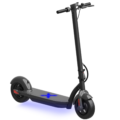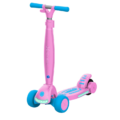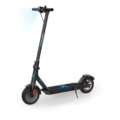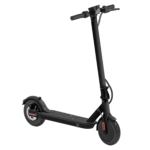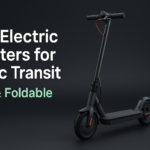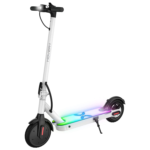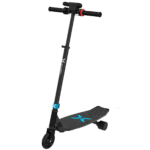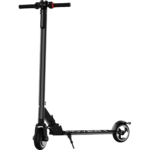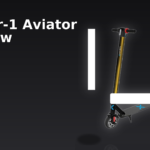- Home
- Scooters
- Electric Scooters
- Hover-1 Alpha Pro
Hover-1 Alpha Pro
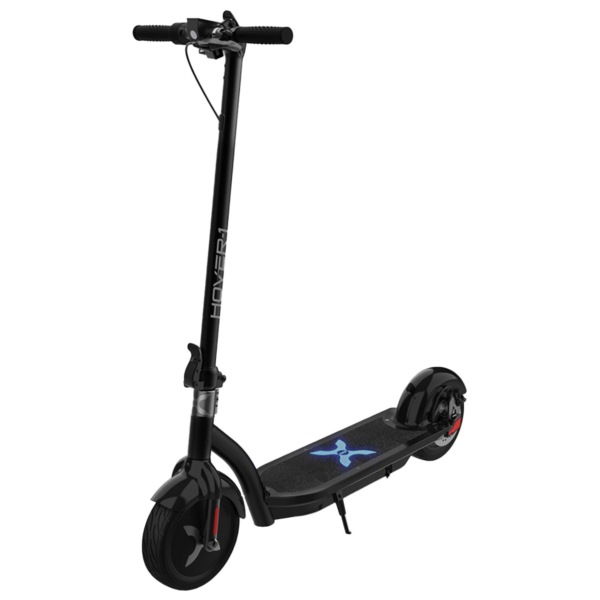

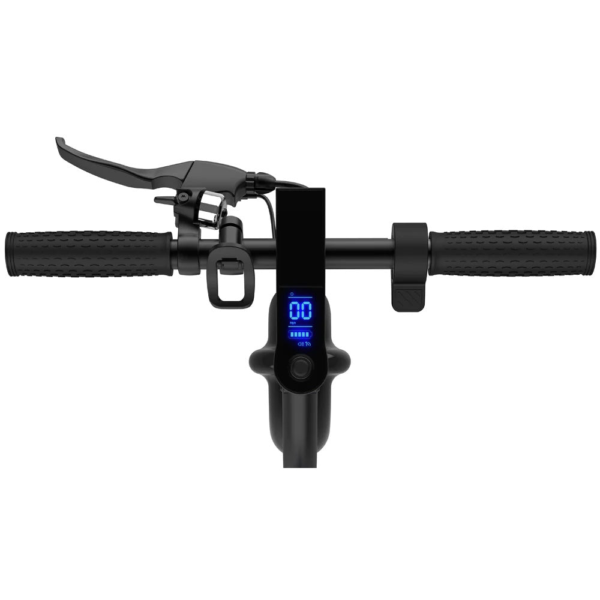
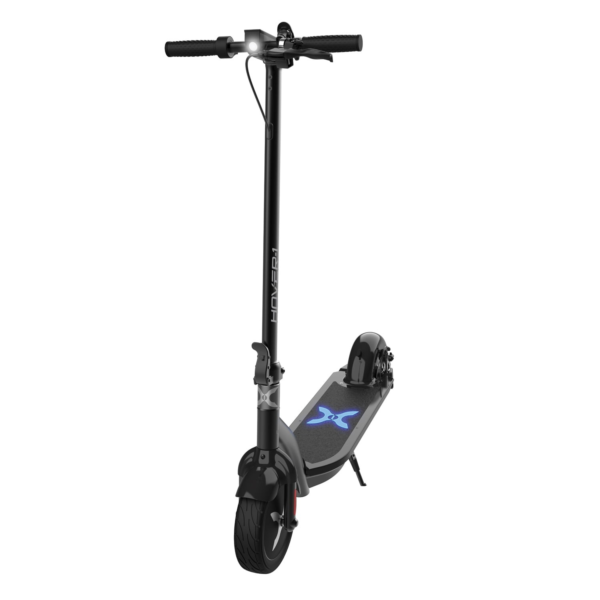
- Battery Range: 18 miles (29 km)
- Top Speed: Not specified
- Motor Power: 450 W brushless hub
- Weight Capacity: 264 lb (120 kg)
- Charging Time: Not specified
- Scooter Weight: 34.4 lb (15.6 kg)
PROS
- Longer 18-mile range
- 10″ pneumatic tires
- Rear disc brake
- Foldable with compact folded size
- LED display
CONS
- Top speed not listed officially
- IP rating not specified
- No stated app features
Table of contents
- What Is the Hover-1 Alpha Pro?
- How the Hover-1 Alpha Pro Works
- Key Specifications
- Design & Build Quality
- Performance Fundamentals
- Battery, Range & Efficiency
- Ride Quality & Comfort
- Braking & Safety Features
- Portability & Daily Usability
- Maintenance & Care
- Weather & Seasonal Considerations
- Hover-1 Alpha Pro vs Alternatives
- Who the Hover-1 Alpha Pro Is (and Isn’t) For
- FAQs
- Glossary
- Final Thoughts
The Hover-1 Alpha Pro is a foldable, entry-level commuter scooter built for short trips, campus hops, and quick errands. It pairs a 450W brushless motor with 10-inch pneumatic tires, a rear disc brake, cruise control, and an easy one-lever fold. This Hover-1 Alpha Pro overview explains what it is, how it works, and how it behaves in daily use—based on the official specs and practical, rider-focused guidance.
What Is the Hover-1 Alpha Pro?
In short, the Alpha Pro is a lightweight, simple electric scooter designed to make everyday travel less stressful. It focuses on predictable handling, straightforward controls, and reasonable performance rather than chasing maximum speed. With a 36V lithium-ion battery (8.25Ah) and a 450W hub motor, it targets riders who want an all-in-one commuter that’s easy to carry, easy to charge, and easy to ride.
The scooter tops out at 18 mph (29 km/h) and is rated for up to 18 miles (29 km) of range under ideal conditions. Because it uses air-filled 10-inch tires, it rides more comfortably than many budget scooters with solid rubber wheels. It also includes a rear disc brake, an electronic throttle, and cruise control for steady pacing on longer straightaways. Furthermore, the on-bar LED display shows speed, mode, and battery level at a glance.
Importantly, the Alpha Pro keeps maintenance simple. The drivetrain is a single rear hub motor; there’s no belt or chain to tension. The mechanical rear disc brake is easy to understand and adjust. In addition, the folding latch is a one-lever design with a magnetic catch for the folded position, which helps during quick train or bus transfers.
How the Hover-1 Alpha Pro Works
Although the Alpha Pro contains several electronic subsystems, you can think about it like a very simple vehicle.
Motor & Controller. The rear wheel hides a 450W brushless hub motor. A controller inside the deck meters battery power to that motor. When you squeeze the mechanical brake, the motor stops driving; you do not get strong electronic braking on this model, so stopping relies mainly on the disc brake.
Battery & Charging. The battery pack sits in the deck: 36V, 8.25Ah, roughly 297Wh of energy. You plug a wall charger into the charging port on the side of the deck. A full charge from low typically takes up to 5 hours. The pack operates best in moderate temperatures; like any lithium-ion battery, it will deliver less range in the cold.
Throttle & Speed Modes. The right-hand thumb throttle sends a signal to the controller. The scooter uses kick-to-start: it won’t accelerate until you’re rolling at about 1.8 mph (3 km/h). There are two speed modes—Low (≈12 mph / 19 km/h) and High (≈18 mph / 29 km/h)—so you can dial back speed where space is tight.
Brakes & Lights. A hand lever on the left actuates the rear disc brake. Lighting includes a forward headlight, a rear brake light, and deck lighting for visibility. Because the scooter emphasizes basic commuting, lighting is functional rather than ornamental.
Cruise Control. When you tap the throttle twice at a steady speed above about 3 mph (5 km/h), cruise control locks your pace. Squeezing the brake or tapping the throttle again cancels it. Think of this as a “hand saver” for longer straight stretches.
Key Specifications
The table below compiles the Alpha Pro’s official numbers and practical measurements in both US and metric units.
General
| Item | Details |
|---|---|
| Brand / Model | Hover-1 Alpha Pro (H1-ALPRO) |
| Rider Weight (max) | 264 lb (120 kg) |
| Scooter Weight | 34.4 lb (15.6 kg) |
| Intended Use | Short-range commuting, campus, errands |
Performance & Power
| Item | Details |
|---|---|
| Motor | 450W brushless rear hub |
| Top Speed | 18 mph (29 km/h) |
| Speed Modes | 2 modes: Low (~12 mph / 19 km/h), High (~18 mph / 29 km/h) |
| Hill Guidance | Best on moderate grades; short 7–10% hills manageable with momentum |
Battery, Charging & Electrical
| Item | Details |
|---|---|
| Battery | 36V 8.25Ah lithium-ion (~297Wh) |
| Rated Range | up to 18 mi (29 km) |
| Charge Time | up to 5 hours from low |
| Charger Input | 100–240V AC, 50/60 Hz |
| Cruise Control | Yes (double-tap throttle above ~3 mph / 5 km/h) |
| Display | LED display (speed, mode, battery) |
| Bluetooth Speaker | Built-in (audio playback) |
Build & Dimensions
| Item | Details |
|---|---|
| Frame | Foldable aluminum stem with deck-mounted battery |
| Tires | 10 in pneumatic, front & rear (inflated rubber) |
| Recommended Tire Pressure | ~340 kPa (~49 psi) |
| Folded Dimensions | 45.0 × 16.9 × 20.7 in (114.3 × 43.0 × 52.8 cm) |
| Unfolded Dimensions | 45.0 × 16.9 × 47.7 in (114.3 × 43.0 × 121.3 cm) |
| Folding Mechanism | One-lever hinge with magnetic latch when folded |
Safety & Control
| Item | Details |
|---|---|
| Brakes | Rear disc brake (hand-actuated) |
| Throttle | Electronic thumb throttle; kick-to-start (~1.8 mph / 3 km/h) |
| Lights | Headlight, rear brake light, deck lighting |
| Reflectors | Not standard on the scooter; use high-visibility gear |
| IP Rating | Not specified; avoid water exposure |
Features & Extras
| Item | Details |
|---|---|
| Cruise Control | Yes (tap throttle twice to activate) |
| Speed Modes | Two (Low / High) |
| Kickstand | Included |
| Bell | Included |
Warranty & Compliance
| Item | Details |
|---|---|
| Warranty | 90-day limited parts & labor (manufacturer defects) |
| FCC | Part 15 device |
| Certification (manual) | UL2272 |
| FCC ID / BT ID | 2AANZALPHA20G / D042258 |
Design & Build Quality
The Alpha Pro aims for smart simplicity. The folding stem uses a single latch that is easy to operate, and the magnetic hook that captures the stem to the rear fender is genuinely useful when you need one-handed control of the folded scooter. The stem has modest flex if you yank on it while stationary, yet it settles at speed thanks to the 10-inch tires. The deck houses the battery and controller, and it feels solid underfoot, with enough width for a natural stance.
Up front, the cockpit is clean: throttle on the right, brake lever on the left, and a compact central display. Because the display is bright and minimal, you can glance at speed or battery without distraction. The bell sits within thumb reach for quick alerts.
Fit-and-finish is consistent for the price class. The painted surfaces and molded plastic fenders are tidy, and the cable routing hugs the stem. The rear rotor and caliper are exposed but tucked in, so you can inspect pad wear easily. Since the scooter uses pneumatic tires, the rims include standard Schrader valves for routine fills at any gas station pump—handy when you’re on the go.
Performance Fundamentals
Acceleration. Off the line, the Alpha Pro feels predictable rather than aggressive. The kick-to-start requirement makes the first push deliberate, which helps new riders. In High mode, the motor builds to pace smoothly, and you’ll reach 15–18 mph on flat pavement without drama. If you’re used to performance scooters, this tune feels mild; however, for commutes through mixed pedestrian traffic, the calmer response is a plus.
Cruising Stability. The 10-inch air-filled tires are the quiet star here. They round off sharp bumps, reduce bar chatter, and make small cracks less stressful. Consequently, the scooter tracks straight at 10–15 mph with little steering input. Near top speed, you may feel light stem wiggles on rough surfaces, but a firm stance over the deck calms it.
Climbing. Short 7–10% grades are in range if you enter with momentum. On longer climbs, expect speed to fall into the low to mid teens. Because the motor is a single 450W unit, pacing and rider input matter; bend your knees, keep weight over the deck, and let the controller do steady work rather than asking for bursts on steep sections.
Battery, Range & Efficiency
The pack is 36V / 8.25Ah—roughly 297Wh. Under gentle riding, light winds, and smooth asphalt, you can approach the rated 18 miles (29 km). However, range is a moving target. It changes with rider weight, temperature, elevation, and tire pressure.
- Rider Weight. Heavier riders consume more watt-hours per mile, which shortens range. Because the scooter supports up to 264 lb (120 kg), it remains usable for many adults, yet lighter riders will always travel farther on the same charge.
- Terrain & Speed. Hills and stop-and-go traffic draw more current. Likewise, cruising at 18 mph uses more power than cruising at 12–14 mph. If you need maximum distance, slide into Low mode and hold a steady pace.
- Temperature. Cold weather reduces available capacity. Above 32°F (0°C) the scooter operates, yet range can drop noticeably until the pack warms. Conversely, extreme heat isn’t ideal either; store and charge in moderate conditions.
- Tire Pressure. At around 340 kPa (~49 psi), rolling resistance stays low. Under-inflated tires feel plush but waste energy; verify pressure weekly.
Charging Habits. Plan up to 5 hours for a full charge from low. It’s fine to top up mid-day; partial charges are gentle on lithium-ion packs. Avoid storing fully depleted, and if you’ll shelve the scooter for weeks, charge to roughly 50–70% and refresh every couple of months. Additionally, keep the charge port clean and dry before connecting the plug.
Ride Quality & Comfort
Comfort on budget scooters often comes from tires rather than suspension. Here, the 10-inch pneumatic setup does the heavy lifting. It filters out chip seal buzz and small pothole edges far better than solid tires. You still need to read the road—square-edged hits can pinch-flat, and deep potholes are never safe—yet everyday seams and driveway lips become manageable.
The deck offers enough length for a natural stance, front foot angled and rear foot braced. Because there is no stem height adjustment, taller riders can feel slightly hunched compared to premium commuters, but the bar position is decent for most adults. Moreover, the cruise control feature reduces thumb fatigue on long straight bike-path sections.
At speed, stem flex is modest and within expectations for a single-latch design. If you ever notice play at the hinge, tighten the latch as shown in the manual and check the bolts—small tune-ups keep the steering crisp.
Braking & Safety Features
The Alpha Pro relies on a rear mechanical disc for stopping. Lever feel is firmer once the pads bed in, and you’ll get the best results by shifting weight rearward while squeezing progressively. Because there is no strong regenerative braking to assist, braking distances are longer than on dual-braked or hydraulic setups; therefore, look farther ahead and modulate early.
Lighting covers the basics: a headlight, a rear brake light, and deck lighting for visibility. Even so, dusk and night riding demand bright clothing or additional reflectivity, especially since the scooter does not ship with side reflectors. Consider a helmet light for conspicuity.
Weather caution. The scooter does not publish an IP rating. The manual advises avoiding water exposure. Consequently, treat this as a fair-weather commuter: ride dry roads, store indoors, and don’t hose it down after a dusty trip—wipe it clean instead.
Portability & Daily Usability
At 34.4 lb (15.6 kg), the Alpha Pro is carry-able for one flight of stairs and manageable on trains or buses. The 45 × 16.9 × 20.7 in (114.3 × 43 × 52.8 cm) folded size fits under many office desks or in a hatchback trunk without drama. The magnetic latch between the stem and rear fender is a small but meaningful touch; it keeps the scooter compact while you’re juggling doors or tap cards.
The kickstand is sturdy enough for flat sidewalks. The deck height is moderate, so curb-cuts are easy to roll over at an angle. For security, use a hardened U-lock through the rear wheel and frame where possible, and never leave a charging scooter unattended in public spaces.
Maintenance & Care
Although the Alpha Pro is approachable, it still benefits from regular, light maintenance. Here’s a simple schedule that works well for commuter use.
Before every ride (30 seconds):
- Check tire pressure; top up if below ~49 psi (340 kPa).
- Squeeze the brake lever; make sure bite starts within the first half of the pull.
- Verify the hinge latch is fully closed and the stem has no wobble.
- Scan for loose bolts or rattles; nip up anything obviously loose.
Weekly:
- Inspect brake pads for glazing or thinness; adjust cable tension if the lever travel grows long.
- Wipe the deck and stem; keep the charge port and cap free of dust.
- Confirm both lights work.
Monthly:
- Check all major fasteners (hinge, handlebar clamp, caliper, rotor bolts) with the correct hex keys.
- Spin wheels and listen for bearing noise; gritty sounds require service.
- Evaluate tire tread and sidewalls for cuts.
Battery & firmware habits:
- Keep the battery between ~20% and 90% during heavy weekly use when practical.
- Store indoors, away from extreme heat or cold.
- If unused for weeks, charge to ~50–70% and refresh every 1–2 months.
Weather & Seasonal Considerations
Rain. Because there’s no stated IP rating, avoid wet riding. Water can reduce braking friction, hide hazards, and damage electronics. If you get caught in a sprinkle, slow down dramatically and dry the scooter thoroughly afterward, especially around the charge port and under-deck seams.
Cold. Below 40°F (4°C), range drops. Rubber stiffens, traction falls, and the battery’s available energy shrinks. Inflate tires near the recommended pressure to reduce rolling losses, but ride slower to maintain grip.
Heat. High summer temperatures are kinder to range but tough on battery longevity. Never leave the scooter baking in a closed car. After hot rides, let the pack cool for 20–30 minutes before charging.
Dust & grit. On dry paths, debris can accumulate around the brake caliper. Periodically brush it clean so pad wear remains even and quiet.
Hover-1 Alpha Pro vs Alternatives
In the broader scooter landscape, the Alpha Pro sits in the affordable commuter class. It outshines many budget rivals that use solid tires, because the 10-inch pneumatics improve comfort and control. It also offers a clearer display and a more reassuring brake feel than the most basic models. Because it weighs roughly 34 lb, it’s easier to carry than heavier dual-motor scooters.
However, mid-tier commuters with dual brakes, suspension, or larger batteries will stop harder, ride softer over potholes, and travel farther. Performance scooters with beefier motors climb steep hills faster, yet they’re heavier, costlier, and more demanding to store. Off-road-oriented scooters add knobby tires and suspension travel, but they compromise on portability and often exceed campus or path speed norms.
Where the Alpha Pro excels: short, predictable commutes on paved paths; multi-modal travel where folding and carrying matter; new riders who want a straightforward control layout; and anyone who values an easy tire/rotor check on the weekend. If you want a step-up option with stronger hill performance while staying commuter-friendly, see the Hover-1 Boss R500.
Who the Hover-1 Alpha Pro Is (and Isn’t) For
Great for:
- Daily last-mile connections to transit or rideshare.
- Students and campus staff who need quick, low-stress moves between buildings.
- Urban errands under 5–7 miles each way on mostly flat ground.
- New riders who want gentle acceleration, cruise control, and a clear display.
Not ideal for:
- Heavy hill climbs or long 15–20 mile one-way commutes at high speed.
- Wet-weather riders, since water exposure isn’t recommended.
- Riders seeking plush suspension or hydraulic braking feel.
- Frequent off-road use on gravel or rough trails.
FAQs
1) How fast does the Alpha Pro go?
It reaches up to 18 mph (29 km/h) on flat ground in High mode. Low mode caps speed at roughly 12 mph (19 km/h) for calmer areas.
2) What range can I realistically expect?
Plan on 10–15 miles (16–24 km) for typical mixed riding, with the full 18 miles (29 km) possible under lighter loads, warm temperatures, and steady pacing.
3) Can I ride it in the rain?
No. There’s no official IP rating, and the manual advises against water exposure. Save rides for dry conditions and store the scooter indoors.
4) Does it have regenerative braking?
Braking is primarily mechanical via the rear disc. You do not get strong regen; therefore, anticipate longer stopping distances and modulate early.
5) Is cruise control included?
Yes. Double-tap the throttle above ~3 mph (5 km/h) to lock your speed. Squeeze the brake or tap the throttle again to cancel.
6) What tire pressure works best?
Hover-1 lists about 340 kPa (~49 psi). Check weekly; under-inflation hurts range and steering precision.
7) Where can I find a concise Hover-1 Alpha Pro overview?
You’re reading it—the Hover-1 Alpha Pro overview here covers what it is, key numbers, and how to use it wisely.
Glossary
- Ah (Amp-hour): Battery capacity measure; 8.25Ah here. Higher Ah means more stored energy.
- Wh (Watt-hour): Energy measure; voltage × amp-hours. The Alpha Pro’s pack is ~297Wh (36V × 8.25Ah).
- Brushless Hub Motor: Electric motor built into the wheel. Efficient and low-maintenance.
- Controller: The electronic unit that meters battery power to the motor based on throttle input and safety limits.
- Kick-to-Start: Safety feature requiring a small push (~1.8 mph / 3 km/h) before the throttle engages.
- Cruise Control: Function that maintains a constant speed until canceled by brake or throttle input.
- Stem Flex: Small forward/back movement of the handlebar stem; normal in folding designs but should be minimal while riding.
- Pneumatic Tires: Air-filled tires. They cushion bumps better than solid rubber but require pressure checks.
- IP Rating: Ingress Protection code for water/dust resistance. The Alpha Pro does not publish one.
- Regenerative Braking (Regen): Uses the motor to slow the wheel and recover energy; not a primary feature on this scooter.
- UL2272: Electrical safety certification referenced in the manual.
- FCC Part 15: Compliance for the scooter’s electronics to limit radio interference.
- kPa / psi: Pressure units; 340 kPa ≈ 49 psi recommended for the tires.
- Mode: Speed setting; Low for calmer spaces, High for open paths.
- Watt (W) / Kilowatt (kW): Power units; 450W describes the motor’s rated output.
Final Thoughts
The Hover-1 Alpha Pro delivers a calm, comfortable ride for daily short-range use. Its strengths are clear: simple folding and carrying, practical top speed, air-filled tires for real comfort, and a clean cockpit with cruise control. Because it favors predictability over peak power, it suits riders who prize ease and portability more than hill-crushing performance. If your typical day includes short hops on dry pavement and a few stair carries, the Alpha Pro fits nicely—and it keeps maintenance light.
Specifications
General
| Model The Model specifies the exact version or name of the scooter. It helps identify its unique design, features, and specifications within the manufacturer’s product line. Knowing the model makes it easier to compare options, find compatible accessories, or look up support information. | Alpha Pro |
| Brand The Brand identifies the manufacturer or company that designs and produces the scooter. A trusted brand is a sign of quality, reliability, and good customer support. Well-known brands often have higher standards for safety, performance, and after-sales service, giving you more confidence in your purchase. | Hover-1 |
| Release Date The Release Date indicates when the scooter model was officially launched on the market. This helps you know how current the design, technology, and features are. A newer release date often means updated components, improved performance, and the latest safety or smart features. | 17 November 2025 |
| Recommended Age Recommended Age indicates the minimum age range that the scooter is designed for, based on safety, size, and ease of use. Following the recommended age helps ensure that riders can handle the scooter’s speed, weight, and controls comfortably and safely. Always check local laws and use protective gear, especially for younger riders. | 16+ |
Performance & Power
| Motor Power (Wattage) What it means: The motor power, measured in watts (W), shows how strong the scooter’s electric motor is. Why it matters: Higher wattage usually means better acceleration, more torque, and improved performance on hills or rough terrain. For example, a 250W motor is good for flat city roads and light riders, while a 500W or 1000W motor provides more power for faster speeds or climbing steep inclines. | 450 W brushless hub motor |
| Top Speed The Top Speed indicates the maximum speed that the scooter can reach under optimal conditions. It’s usually measured on level ground with a fully charged battery and an average rider weight. A higher top speed allows you to travel longer distances faster, but always ensure you ride within legal speed limits and your personal comfort zone for safety. | Not specified |
| Battery Capacity Battery Capacity refers to the total amount of energy the scooter’s battery can store, usually measured in ampere-hours (Ah) or watt-hours (Wh). A higher battery capacity means you can ride longer distances on a single charge, reducing the need for frequent recharging. Keep in mind that actual range can vary depending on rider weight, terrain, speed, and weather conditions. | 36 V 8.25 Ah (297 Wh) |
| Estimated Range per Charge The Estimated Range per Charge indicates the average distance the scooter can travel on a single full battery charge. This range is calculated under optimal conditions, such as flat terrain, moderate speed, and average rider weight. Real-world range may vary depending on riding style, terrain, weather, and load. A longer range means fewer recharges and greater freedom for longer trips. | up to 18 miles (29 km) |
| Hill Climb Ability Hill Climb Ability describes the maximum incline or slope that the scooter can handle while maintaining stable performance. It’s typically expressed as a percentage or in degrees. A higher hill climb rating means the scooter can tackle steeper hills without losing too much speed or power. Actual climbing performance may vary based on rider weight, battery charge, and terrain conditions. | Not specified |
| Drive System The Drive System refers to how power from the motor is delivered to the wheels. Electric scooters typically use either a hub motor (directly integrated into the wheel) or a chain/belt drive system. A high-quality drive system ensures smooth acceleration, efficient power transfer, and low maintenance. The choice of drive system affects performance, noise level, and overall ride experience. | Not specified |
Charging & Electrical
| Charging Time Charging Time indicates how long it takes to fully recharge the scooter’s battery from empty to 100% using the standard charger provided. Faster charging means less downtime and more time on the road. Actual charging time may vary slightly depending on battery capacity, charger output, and environmental conditions. | Not specified |
| Battery Type Battery Type refers to the specific technology used in the scooter’s battery, which affects performance, lifespan, weight, and charging time. Most modern electric scooters use high-quality lithium-ion (Li-ion) batteries because they offer a good balance of energy density, durability, and low maintenance. A reliable battery type ensures consistent power delivery and longer riding ranges. | Lithium-ion battery (BMS not specified) |
| Removable Battery A Removable Battery means the battery pack can be easily detached from the scooter for convenient charging and replacement. This feature allows you to charge the battery separately, swap it with a spare for extended range, or securely store it indoors in extreme weather. Removable batteries add flexibility and make it easier to keep your scooter powered up wherever you are. | Non-removable internal battery (fixed pack) |
| Regenerative Braking Regenerative Braking is an energy-saving feature that converts some of the energy normally lost during braking back into battery power. When you slow down or brake, the motor works in reverse to generate electricity, which helps extend the scooter’s range and improves overall efficiency. This system also reduces wear on traditional brake components, leading to lower maintenance over time. | Not specified |
| Lighting Lighting refers to the built-in front and rear lights that enhance visibility and safety when riding in low-light conditions or at night. Good lighting helps you see the road ahead and ensures that other road users can see you. Many scooters include LED headlights, taillights, and sometimes brake lights or side reflectors for added safety and compliance with local traffic regulations. | LED headlight + rear LED; reflectors |
Build & Dimensions
| Scooter Weight Scooter Weight refers to the total weight of the scooter when fully assembled, including the battery. This affects how easy it is to carry, lift, and store the scooter when not in use. A lighter scooter is more portable and convenient for commuting, especially if you need to carry it upstairs or onto public transport. Keep in mind that a sturdy frame and quality components may add to the weight but also contribute to better durability and ride stability. | 34.4 lb (15.6 kg) |
| Maximum Rider Weight Maximum Rider Weight indicates the highest rider weight that the scooter is designed to safely support while maintaining optimal performance and stability. Staying within this limit helps ensure reliable acceleration, braking, and climbing ability, and it protects the frame, suspension, and motor from excessive strain. Exceeding the recommended limit may reduce performance and increase wear on components. | 264 lb (120 kg) |
| Deck Size Deck Size refers to the dimensions of the scooter’s standing platform. A wider and longer deck provides more foot space, allowing you to stand comfortably and adjust your stance while riding. A well-sized deck improves balance and stability, especially on longer rides or at higher speeds. Compact decks, on the other hand, help keep the scooter lightweight and portable. | One-level fold; wider deck |
| Handlebar Height Handlebar Height refers to the distance from the deck to the handlebars, which affects your riding posture and comfort. An appropriate handlebar height helps you maintain good balance, reduces strain on your back and arms, and makes steering more comfortable. Some scooters have adjustable handlebars to fit riders of different heights, while others have a fixed height for a streamlined design. | Fixed |
| Folding Mechanism The Folding Mechanism describes how easily and securely the scooter can be folded for carrying and storage. A well-designed folding system lets you quickly collapse the scooter into a compact size, making it convenient to transport on public transit, store under a desk, or fit into a car trunk. Look for sturdy latches and safety locks to ensure the scooter stays firmly in place when folded or unfolded. | Quick fold latch |
| Dimensions Folded Dimensions indicate the size of the scooter when it’s fully folded. This measurement shows how much space the scooter will take up when stored or carried, making it easier to check if it will fit in your car trunk, under a desk, or in a closet. Compact folded dimensions are ideal for commuters who need to bring their scooter on public transport or store it in tight spaces. | Folded: 45.0 × 16.9 × 20.7 in (114.3 × 42.9 × 52.6 cm); Unfolded: 45.0 × 16.9 × 47.7 in (114.3 × 42.9 × 121.2 cm) |
| Material Material refers to the primary construction materials used for the scooter’s frame and key components. High-quality materials like aircraft-grade aluminum, reinforced steel, or durable composites provide strength, stability, and a lighter overall weight. A sturdy material ensures the scooter can handle daily wear and tear while maintaining safety and performance. | Aluminum alloy |
Safety & Control
| Brake Type(s) Brake Type(s) describe the braking systems the scooter uses to help you slow down or stop safely. Common brake types include mechanical brakes (like drum or disc brakes), electronic brakes, and foot brakes. Many scooters combine multiple braking systems for added safety and shorter stopping distances. The type and quality of brakes affect your control, especially when riding at higher speeds or on slopes. | Rear disc brake |
| Suspension Suspension refers to the system that absorbs shocks and vibrations while riding, providing a smoother and more comfortable ride over uneven or rough surfaces. Scooters may have front suspension, rear suspension, or dual suspension for better shock absorption and stability. Good suspension helps reduce rider fatigue and improves control, especially when riding on bumpy roads or off-road paths. | None |
| Tire Type Tire Type refers to the kind of tires the scooter uses, which directly affects ride comfort, traction, and maintenance. Common types include solid (airless) tires, pneumatic (air-filled) tires, or hybrid options. Pneumatic tires offer better shock absorption and a smoother ride on rough surfaces, while solid tires are puncture-proof and require less upkeep. The right tire type helps ensure safe handling and a comfortable ride in different conditions. | 10″ pneumatic tires |
| Tire Size Tire Size indicates the diameter and width of the scooter’s tires, which affect ride comfort, stability, and how well the scooter handles different terrains. Larger tires generally offer better shock absorption and a smoother ride over bumps and rough surfaces, while smaller tires keep the scooter lighter and more portable. Choosing the right tire size helps ensure a balance between agility and comfort. | 10-inch |
| Kickstand The Kickstand is a built-in stand that allows you to park your scooter upright when it’s not in use. A sturdy kickstand keeps the scooter stable and prevents it from tipping over, protecting it from scratches and damage. It also makes storing and accessing your scooter more convenient, whether you’re at home, work, or on the go. | Side kickstand |
| Water Resistance Rating Water Resistance Rating indicates how well the scooter is protected against water and moisture, usually shown as an IP (Ingress Protection) rating. This rating helps you understand whether the scooter can handle light rain, splashes, or wet roads without damage. While most scooters are not fully waterproof, a good water resistance rating adds peace of mind when riding in changing weather conditions. Always avoid deep puddles or submerging the scooter to protect its electrical components. | Not specified |
Features & Extras
| Display/Console The Display (or Console) shows important real-time information about your ride, helping you monitor your scooter’s status at a glance. Typical displays show speed, battery level, distance traveled, and riding mode. Some models also include additional features like Bluetooth connectivity, app integration, or backlighting for better visibility at night. A clear and easy-to-read display enhances safety and convenience on every trip. | LED display (speed, battery) |
| Ride Modes Ride Modes refer to the different speed and power settings you can choose to match your riding style or road conditions. Common modes include eco for maximum range and energy efficiency, standard for everyday balance, and sport or turbo for higher speed and stronger acceleration. Switching between ride modes allows you to customize performance, conserve battery, and ride safely in various environments. | Not specified |
| Smart App Connectivity Smart App Connectivity lets you pair your scooter with a dedicated mobile app via Bluetooth. Using the app, you can monitor real-time ride stats like speed, battery level, and range, adjust settings such as ride modes or cruise control, lock the scooter for added security, and sometimes receive firmware updates. This feature adds convenience and allows you to personalize your riding experience right from your smartphone. | Not specified |
| Anti-Theft System The Anti-Theft System helps protect your scooter from unauthorized use or theft. This feature can include built-in alarms, electronic motor locks, GPS tracking, or remote locking through a mobile app. A good anti-theft system provides peace of mind when parking your scooter in public spaces, adding an extra layer of security to safeguard your investment. | Not specified |
| Cruise Control Cruise Control allows you to maintain a steady speed without continuously holding the throttle. This feature makes longer rides more comfortable by reducing hand fatigue and providing a smoother, more relaxed riding experience — especially on flat, open roads or bike lanes. For safety, cruise control can usually be easily activated or deactivated while riding. | Not specified |
| Accessories Included Accessories Included lists the additional items that come with the scooter to enhance your riding experience and convenience. Common accessories may include a charger, kickstand, bell, lights, phone holder, or carrying strap. These extras add value by making your scooter safer, easier to use, and ready to ride straight out of the box. | Scooter, wall charger, manual |
Warranty & Compliance
| Warranty Period The Warranty Period indicates how long the manufacturer guarantees the scooter against defects in materials and workmanship under normal use. A good warranty provides peace of mind, showing the brand’s confidence in its product quality. Always check what parts are covered, such as the frame, battery, and motor, and follow the maintenance guidelines to keep your warranty valid. | Region-dependent (limited warranty) |
| Certifications Certifications confirm that the scooter meets specific safety, quality, and environmental standards set by recognized organizations or regulatory bodies. Common certifications may include CE, RoHS, UL, or other local compliance marks, depending on your region. These certifications ensure that the scooter is manufactured to high standards and is safe and legal to use in your country. | UL 2272 mentioned by retailers; local micromobility rules apply |


